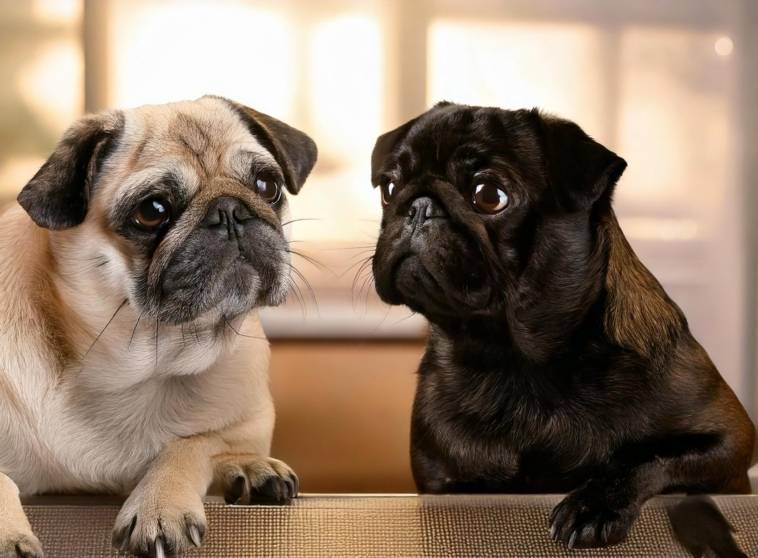Last updated on October 24th, 2024
Here’s an overview:
Introduction: Pug vs French Bulldog
Physical Characteristics and Appearance
Temperament and Personality Traits
Considerations on Health and Lifespan
Grooming and Maintenance Requirements
Living Environment Suitability
Training and Socialization Tips
Cost of Ownership: Pug vs French Bulldog
Pug vs French Bulldog: Family Compatibility
Common Behavior Problems and Their Solutions
Traveling with Pugs and French Bulldogs
Conclusion: Pug vs French Bulldog
Introduction: Pug vs French Bulldog
Pug vs French Bulldog, both of stout frame and petite in structure, unabashedly attract love and admiration. The pug breed, which hails from China, comes with a distinct appearance: a selectively bred dog with a wrinkled head and a tightly curled tail. The French bulldog, which comes from France, has huge bat like ears and is stocky. Both are known for being good companions and able to integrate into households seamlessly.
Characteristics
Size:
- Pugs: Height ranges from 10 to 13 inches
- French Bulldogs: Height ranges from 11 to 12 inches
Weight:
- Pugs: Weight extends between 14 to 18 lbs.
- French Bulldogs: Weight differs between 16 and 28 lbs.
Temperament:
- Pugs: strong need to engage in play, loving, attention seeking
- French bulldogs: gentle temperament, vigilance, able to adapt
Breed History and Origins
Pug
- Dates back to China 2000 years ago.
- They were meant to be lap dogs for the Chinese emperor.
- In the 16th Century Dutch traders spread the breed to Europe with their nobility.
- Characteristically these dogs have wrinkled heads, curled tail and loving disposition.
French Bulldog
- Created in England in the Victorian era of the English Bulldog but a smaller type.
- Made its way to France in the 19th Century and became popular amongst lace knitters.
- The dogs are known for their large bat eared heads, tiny body and playful manner.
- They were developed into their present shape by interbreeding with the local ratter’s.
Both breeds were selectively bred for companionship, although their history differs significantly and comes from different cultures.
Physical Characteristics and Appearance
Pug
- Size: Small breed with a compact build weighing between 14 and 18 pounds on average.
- Facial Features: A short flat muzzle with a wrinkled face that stands out in appearance.
- Coat: A short and smooth type of fur that is fine and meshes well with the pug’s body also commonly is fawn or black in color.
- Ears: Small, round and can either be rose or button type ears.
- Tail: A pug’s tail is that is tightly curled and held over the back.
- Body: Square shaped in appearance and with strong muscles on the frame.
French Bulldog
- Size: Relatively small but stocky, generally weighing between 16 and 28 pounds.
- Facial Features: Large bat ears and an overall flat and squarish face, complete with a short nose.
- Coat: Short, smooth, and soft coat available in many colors including fawn, brindle, and pied.
- Ears: It has large and distinct ears that are high-set.
- Tail: Short and naturally occurs either as straight or screw.
- Body: Compact, well built and a broad chest.
Temperament and Personality Traits
Pugs and French Bulldogs, while very different from each other, have distinct temperaments and personality characteristics that suit different families and people.
Pugs:
- As a whole, Pugs are affectionate dogs that tend to bond with people.
- Normally characterized as playful and even clownish performers.
- Generally have positive interactions with children as well as with other animals.
- Boa for their adaptable nature to any type of environment.
French Bulldogs:
- Please do not hesitate to tell me how can I help you “overwhelmingly lovable and clever.
- Makes even boisterous show dogs seek his or her family’s warmth and comfort.
- Show calmness and patience.
- More offseason territorial than Pugs.
It all comes down to how a person is willing to adapt his/her lifestyle and preference to the each breed.
Exercise and Activity Needs
There are major differences when it comes to exercise between Pugs and French Bulldogs.
Pugs:
- Daily Walks: Around 20-30 minutes at a time but may be broken into two or more time frames.
- Playtime: Mostly seek playing interactive games and toys which involve indoors.
- Risk Factors: Regular exercise is significant as they can easily become over weight.
French Bulldogs:
- Daily Walks: French bulldogs can go for 30-45 minutes a walk which is ideal for longer sessions as well.
- Playtime: Needs a lot of energy and wild engagement.
- Risk Factors: These bulldogs are sensitive to hot weather so exercise must not be very vigorous.
Since both dogs are brachycephalic, it is essential that they are not over exercised which would trigger their breathing issues. All types of prosthetic devices should have regular inspections and adjustments.
Different breeds call for monitoring so that they do not reach a point of exhaustion or overheating.

Considerations on Health and Lifespan
There are also some health and lifespan issues that potential owners should be sensitive to, which are, pugs and french bulldogs, as indicated, their possibilities are rather strikingly different when it comes to:
- The age of a pug reaches twelve to fifteen years while the French bulldog reaches roughly ten to twelve years.
- The snouts of both breeds are short thus suffering from brachycephalic phenomena.
- A pug is most likely to be affected by obesity, some eye issues, and hip dysplasia among some other health risks.
- The French bulldog, on the other hand, is prone to joint disorders, heart diseases, and diseases related to the spine.
- Recommendations on observing particular medical conditions stress the importance of observing a vet regularly.
- Medical costs can be high. Accordingly, it is advisable for owners to prepare themselves to incur such expenses.
Blockquote example:
“Both breeds need the special attention to their care, in order for them to be able to live a healthy life”.
Balanced diet and proper exercise are fundamental for both breeds and are not compulsory but rather natural.
Grooming and Maintenance Requirements
Pugs and French bulldogs both need grooming and maintenance in order to appear healthy.
Pugs:
- Short-haired coat has severe shedding
- Brushing once for a week would lessen intensity of hair shedding.
- The third part is treating the dogs’ contented eyes which are found within facial fur.
- Other activities like cleaning of the ears and nails should be performed also.
French Bulldogs:
- Like the pugs, they have short coats that set the pug hair off.
- They don’t require as much brushing as Pugs but still need it.
- Moisture is often collected in friction points, such as the folds around the mouth.
- There is a need for regular nail and ear care.
You can help both breeds by routine tooth brushing to keep their mouths healthy.
Living Environment Suitability
Pugs and French bulldogs have different requirements regarding their environment.
Pugs:
- Can live in both apartments and houses.
- Due to their short muzzles, are prone to breathing problems in excessive heat and cold.
- Exercise needs are low, which is great for city and suburbs.
French Bulldogs:
- Can live in all types of homes: big and small.
- Susceptible to high temperatures and humidity too.
- Require little exercise but would take a short walk every day.
Both breeds will be okay in a family setting and both will interact well with children and other pets, making them more versatile.
Training and Socialization Tips
- You can train both breeds using positive reinforcement.
- Training a pug will require a lot of patience because pugs tend to be more stubborn.
- Consistency is important in training techniques to control the independent nature of French bulldogs.
- For both types of dogs, it would be essential to socialize them at an early stage to avoid future behaviour problems.
- Let the Pug have a wider window than just the outdoors; include sounds, people, and other environments.
- Under socialization can cause anxiety in French Bulldogs hence a proper schedule should be followed.
- Playdates which are scheduled can be beneficial for both breeds in developing appropriate socialization.
- Make sure to always incorporate treats and praise in order to make training more exciting for the dog.
Cost of Ownership: Pug vs French Bulldog
When comparing the cost of a French Bulldog ownership to a Pug ownership there are several points that should be taken into account:
- Initial Purchase Price: Out of the two, the French bulldog is more expensive and his cost is around 1,500 to 3,000 dollars while the pug’s cost ranges between 800 to 1,500 dollars.
- Health Care: Due to their popularity among pet owners, both pug and French bulldog are known to have different health problems. Due to their breathing issues, pug might have surgery. For French bulldogs, it is more common for them to have hip dysplasia which will lead to increased vet bills.
- Food and Supplies: Due to the smaller size of a pug, feeding them might be cheaper than their counterpart. Also some basic supplies like grooming kits or collars will be cheaper than French Bulldog.
- Insurance: French bulldogs are prone to various diseases so a person will have to pay higher insurance premium if they own a French bulldog.
These criteria also explain why some breeds are more affordable than others and which breed would be optimal for a person’s budget.
Pug vs French Bulldog: Family Compatibility
Both pet owners can feel reassured as Pugs and French Bulldogs have a very gentle and friendly character.
Pugs
- Pugs love to play a lot and have the ability to easily bond with children.
- In terms of other animals, they are relatively tolerant.
- They are famous for their calmness and endurance.
French Bulldogs
- Take pleasure in participating in family events and get along well with the children.
- Could be a bit shy with other pets but will open up readily.
- Their instincts to protect the home make them dependable pets.
While both breeds are well-suited for family life, they do need care and attention. Ensuring that their sociable nature and need to be with other beings is met is crucial to the integration of the family unit.
Common Behavior Problems and Their Solutions
Behavior problems exhibited by Pugs and French Bulldogs are two unique cases in Pugs, these behaviors are often stubborn and it is easy for them to reach an over weight Status through mic valuation.
Behaviour Challenges:
- Pug’s Awareness Lapses and Stubbornness: Pugs’ Lapses affect their training adversely
- Pug Obesity: Due to over eating
Behaviour Issues:
- Lack of patience and use of just a few rewards.
- Their favourite treats are fed often and in large quantities.
The Italian bulldogs feel Pug separation anxiety, they may even bark at people excessively.
Behaviour Problems:
- Pug Separation Anxiety in French bulldogs
- Barking at people excessively
Solutions to these problems include:
- Increasing the time she spends alone gradually starting with short amounts of time reaches the time in an hour gradually up to three hours.
- The amount of exercise one gets on a daily basis in necessary in all cases because French Bulldogs as well as self-protective.
Traveling with Pugs and French Bulldogs
Pugs and French bulldogs are brachycephalic breeds, and because of this travel with them has special considerations. Owners need to consider the following requirements:
- Travel by Air Restrictions: Because of their broad head conformation, most airlines will have restrictions or entirely ban certain brachycephalic breeds.
- Sensitive to Temperature: Ensure an ideal non-extreme temperature environment as overheating can be fatal.
- Ventilated Carriers: Use carriers that are airy and easy to carry.
- Planned Breaks: Schedule frequent stops for water and rest.
- Current Health Records: Updated veterinary documents are recommended in case of any emergency.
Before setting out it is crucial to understand these requirements as it guarantees a safe travel experience.
Adoption and Breeder Tips
Adoption and buying from a breeder largely boil down to which is more suitable for you. Adopting a Pug or a French Bulldog literate jumbo risks considering the following:
- Look for reliable shelters: Take the time to look into their background.
- Request medical papers: Ask for the medical documents of the pet to see if it has any probable illnesses.
While those that are looking for a breeder:
- Check documentation: Make sure that the breeder is registered and is following professional standards.
- Inquire about seeing their home: See the living environment and the parents of the puppy.
- Demand health guarantees: It is standard practice for breeders to provide necessary health clearances on untransmittable puppies.
In both scenarios, one must be cautious in order to find a pet that is clean and healthy.
Conclusion: Pug vs French Bulldog
Pug vs French Bulldog, which is best for you? Several points should be considered while deciding on a Pug or a French Bulldog, particularly lifestyle, grooming, and health factors.
Lifestyle:
- Pugs are more playful and active dogs.
- French Bulldogs tend to sit at the brunt to be more easygoing.
Grooming Needs:
- Both of the two breeds are grooms regularly.
- A more frequent brushing condition is valid for Pug owners due to more shedding.
Health Concerns:
- Respiratory disorders are common in both breeds.
- Pug dogs have more eye problems than normal.
- French Bulldogs may have skeletal problems of the joints.
All the breeds have different characteristics, evaluate these factors in advance to make them compatible with individual needs and abilities.
Article by: Tawab Sukhera (Ethologist)




